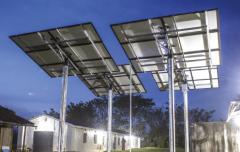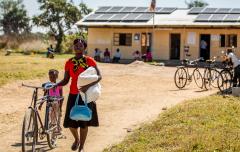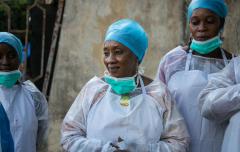Editor's pick: Powering health across Africa through COVID-19 and a changing climate
By Richenda Van Leeuwen and Alexis Tubb (Rocky Mountain Institute)
Modern health services require electricity everywhere in the world. The Sustainable Development Goals, adopted by United Nations Member States in 2015, include access to affordable, reliable, sustainable and modern energy for all by 2030 (SDG 7). This means not only for households, but for all health facilities, everywhere.
Yet today, health clinics and hospitals in sub-Saharan Africa and much of the developing world still remain underserved by the electrical grid. According to the World Health Organization (WHO), one in four health facilities has no access to electricity, and only a third of hospitals have reliable electricity access.
COVID-19 is exacerbating the situation as the pandemic spreads across sub-Saharan Africa. Health facilities require stable power to provide 24/7 care and avoid unnecessary increased mortality. Calls for action have recently been put out by Damilola Ogunbiyi, the UN Secretary-General’s Special Representative for Sustainable Energy for All (SEforALL), and others.
All health facilities require proper ventilation and lighting. Hospitals require reliable electricity to power ventilators, oxygen concentrators, and other essential medical equipment. Urban and peri-urban area clinics use an array of energy-dependent medical equipment. In the current COVID-19 medical response, rural clinics may act as a frontline system for triaging cases for further treatment at larger facilities, in addition to providing their normal suite of services.
Many health facilities across sub-Saharan Africa use diesel backup generators or do without power during blackouts. For critical health services like oxygen provision, policymakers are increasingly turning to renewable energy options.
A pre-COVID-19 example is the 20 kilowatt (kW) solar power and battery array installed in 2018 in the Neonatal Intensive Care Unit in Bo General Hospital in Sierra Leone, where the oxygen concentrators were required to function 24/7 to treat critically ill premature newborns. Following installation, allowing for the uninterrupted operation of oxygen concentrators and baby warmers, infant mortality in the facility plummeted.
Distributed renewable energy systems are more resilient
Solar PV and battery storage-based distributed energy resources (DER) are more resilient during crises and are cleaner and more cost-effective either as an alternative to, or supplemented by, diesel generator use where 24/7 power is required.
The diesel generator supply chain is riddled with volatility. During crises, diesel prices soar, supply becomes scarce and transportation can be difficult. Distributed renewable energy solutions offer a reprieve. After installation, solar PV and lithium-ion or lead acid batteries do not require a supply of a commodity. Even during rainy seasons, the sun usually shines enough to keep batteries functional.
The Rocky Mountain Institute has investigated adding resiliency to critical renewable energy infrastructure in the Caribbean in times of natural disaster (part one and part two). Hospital equipment requires an uninterrupted power supply, which a backup battery can provide in contrast with a diesel genset which has a ramp up time. DERs are also inherently “distributed,” being located at the site of the critical load they serve, reducing the risk of a line outage upstream causing power to go down at the health facility. This further improves resiliency.
DER options cost less than business as usual over their lifetime
Economic savings are an important long-term consideration for medical facilities. In sub-Saharan Africa, urban diesel generators can cost approximately $0.31–0.42 per kilowatt-hour (kWh) to operate. In rural settings costs can reach over $1/kWh. There is also a cost in terms of climate pollutants. Because of the high levels of black carbon emissions and noise pollutants produced by diesel gensets, the WHO has recommended switching to renewable power.
Based on costs obtained by developers in Nigeria, commercial and industrial (C&I)-scale solar PV and battery systems can cost approximately $0.14–0.24/kWh and small-scale solar PV systems $0.22–0.26/kWh over the 20-year lifetime of the system. They thereby more than pay for their initial capital expenditure, compared to a diesel genset, through operational savings, better air quality reducing negative health impacts on nearby populations, and less climate impact.
DER solutions to meet increased energy needs within the next one to five months
The development of a 70–200 kW solar PV capacity and 200–500 kWh lithium-ion battery traditional C&I-scale roof-mounted DER system to back up the electrical load or critical electrical needs of a moderate-sized health clinic or small hospital in developed countries takes 10–16 months from initiation to completion. This includes an energy audit, procurement, contracting, permitting, installation and commissioning. Many health clinics can’t wait that long given the immediacy of the challenge of COVID-19 in sub-Saharan Africa.
There are a range of “pop-up” and pre-manufactured solar and battery systems that can in principle be deployed more rapidly for emergency response. Pre-manufactured off-site, they can be rolled out on site within a few days. The technology options consist primarily of:
- Quick-deploy mini-grid/microgrids: Systems are quickly sized and installed using local installation companies drawing on solar and battery systems already warehoused in-country. Designs may consist of a string of solar home system arrays for speed of implementation. These can be designed within weeks and installed within days, as shown by Nigeria’s Rural Electrification Agency.
- Containerized solar and storage systems: Pre-manufactured shipping containers house solar and storage systems, sometimes with diesel generator back up, that can be deployed on a site within 30 minutes to a day. Pre-manufacturing may take one month, depending on the design and company; shipping may take months, depending on the route.
- Solar-powered mini multi-use facility: Converted shipping containers become mini multi-use facilities serving as testing facilities or for other purposes. Rooftop solar panels power the facility and the battery system is stored inside. Pre-manufacturing, shipping, and set up times vary, but companies have reported this is deployable within months. Such solutions tend to be more expensive and create fewer jobs than constructing the housing for the system locally.
- Minibox solar arrays: Some companies make pre-manufactured boxes, much smaller than shipping containers, which include easy-to-assemble solar arrays that need to be sized carefully to meet the power requirements of the facility.
Examples of companies that offer these options include: EM-ONE, Akuo Power, Winch Energy, GE Renewable Energy, Schneider Electric, Total, and Box Power. Locally designed “pop-up” solar and battery systems have been installed to address COVID-19 related needs in other geographies too, such as by the SELCO Foundation in India.
Two key challenges come with using imported pre-manufactured, DER solutions in COVID-19 response: shipping lead times and the increase in per kWh cost of pre-assembled options. If the DER system is being assembled outside Africa, shipping can typically take 2–3 months. Clearing port and customs can take weeks, or more, during crises.
Local options can, therefore, be prioritized, within specified design and quality parameters. Pre-assembled DER solutions can also be two to four times more expensive per kWh than solar PV and battery systems installed on-site. Cost differences depend on the manufacturer and model, expected lifespan and level of maintenance required.
What DER solutions can meet health facilities’ long-term needs?
COVID-19 is not the first health crisis in sub-Saharan Africa. A longer-term approach incorporating holistic planning at national and local levels is paramount to providing health clinics and hospitals with a resilient, cost-effective electricity supply.
SEforAll has begun compiling resources related to powering health facilities for COVID-19 response to help provide guidance for planners. Such planning is best carried out nationally, to support economies of scale in equipment procurement, while recognizing that the burden of disease and exact equipment requirements will vary locally.
Hospitals and large urban health clinics connected to the grid with unreliable power can take advantage of solar PV and battery systems supplying backup power when needed and help save on electricity bills.
Rural health clinics receiving limited or no electricity from the grid can use solar PV and battery microgrids, with a small diesel genset where required, to meet all their power needs more cost effectively and cleanly than solely using diesel generators.
But it is important that holistic needs of clinics are met. While the need for electricity to ensure cold chains for vaccination is well understood, well-intentioned donor efforts have often led to only partial electrification of facilities. For example, a small solar power system might keep vaccines cool, while nurses attending a woman giving birth in a room next door lack power for lighting to guide her during labor.
Ongoing maintenance is equally key to the life of any system; Sub-Saharan Africa is peppered with abandoned donated solar systems. Maintenance budget lines in health facilities are needed, as is contracting with reputable service companies that know solar systems.
Renewable energy systems are increasingly playing a long-term role in powering modern health care provision. Donors and policymakers focused on tackling COVID-19 should look not only to powering hospitals and health clinics using renewable energy solutions through the immediate crisis, but also to established best practices in embracing resilient, clean and climate-friendly renewable power to enable modern health care delivery everyday and everywhere.
This will save lives today and over the longer-term help countries build resilient health systems, save on fuel costs and avoid emissions contributing to climate change.
This article was first published by the Rocky Mountain Institute (RMI).
Richenda Van Leeuwen is the Managing Director for Empowering Clean Economies at the RMI. Alexis Tubb is a Senior Associate with RMI’s Sustainable Energy for Economic Development (SEED) program.
Related content

Research
24 Apr 2019

Blog
29 Apr 2020

News
17 Apr 2020

Blog
01 Apr 2020
